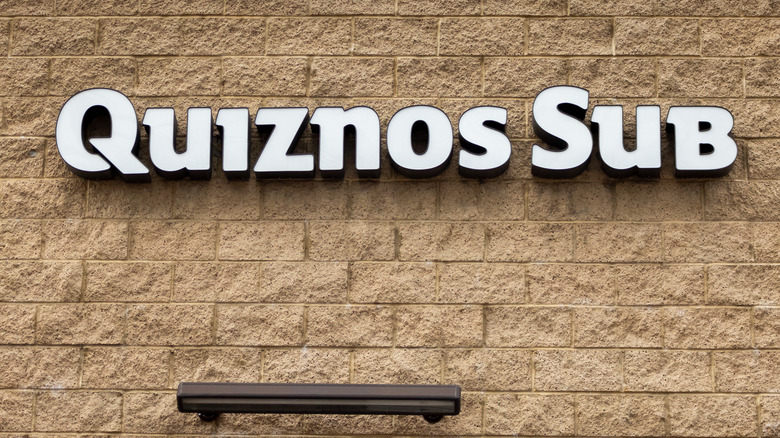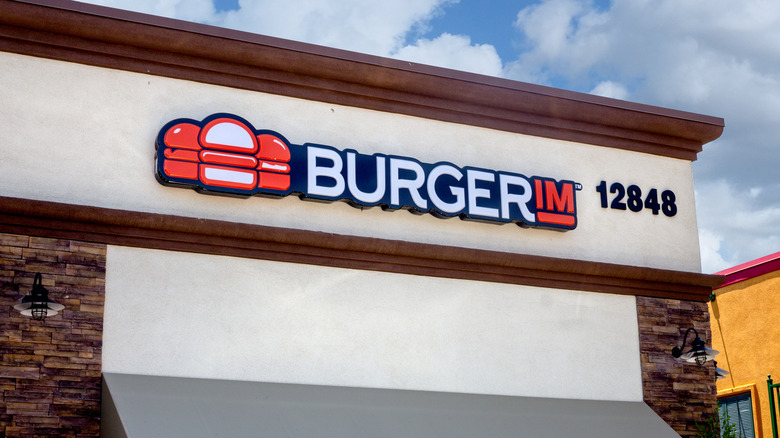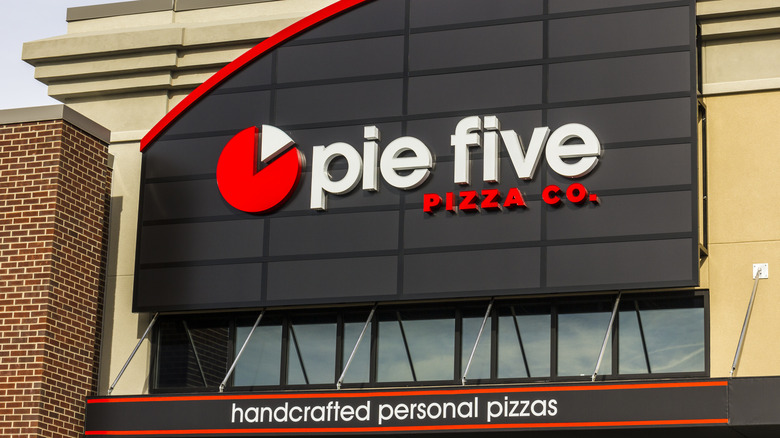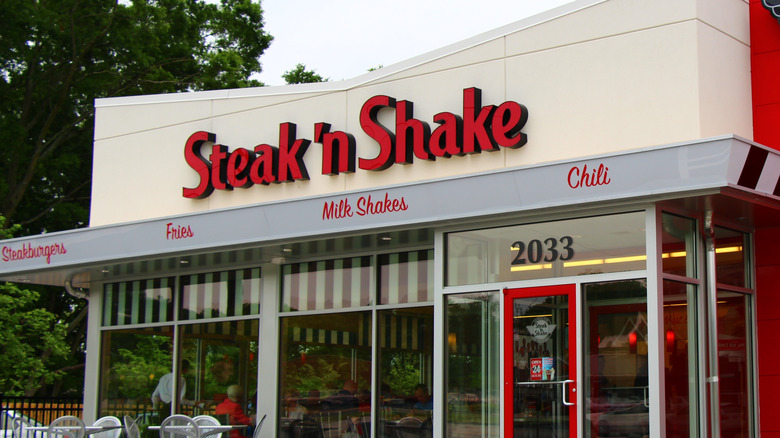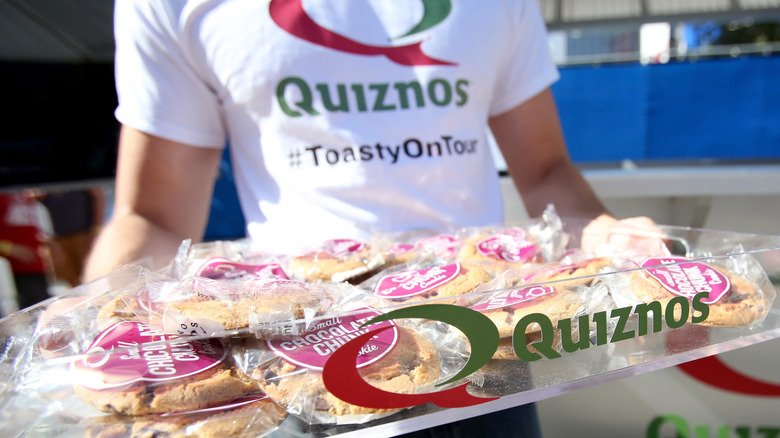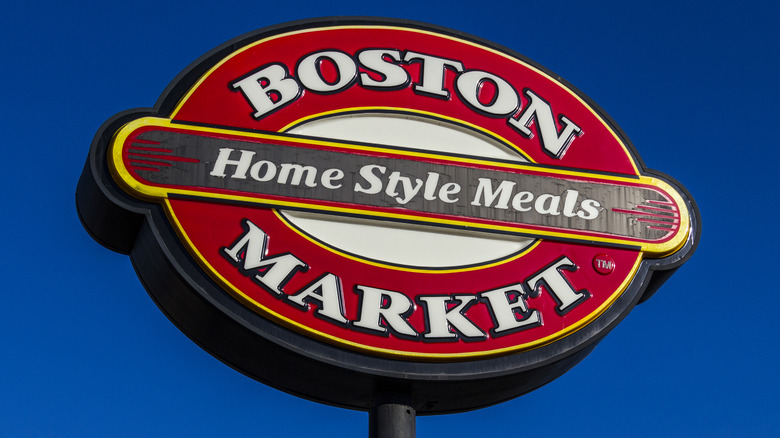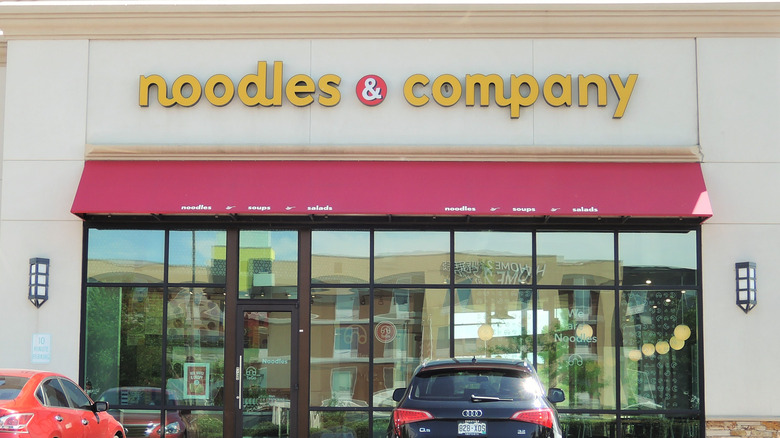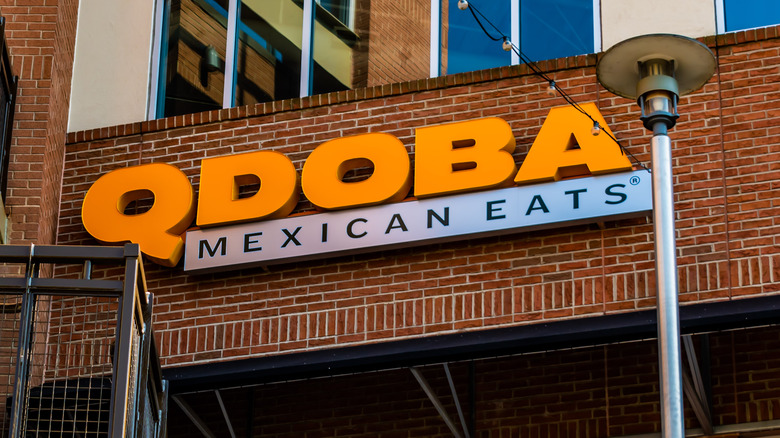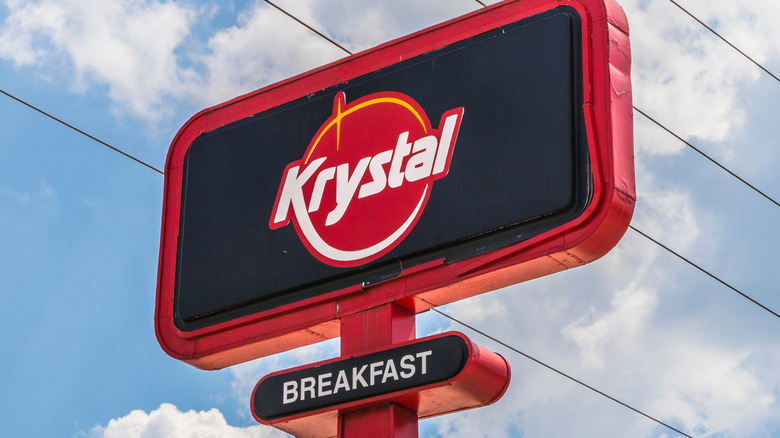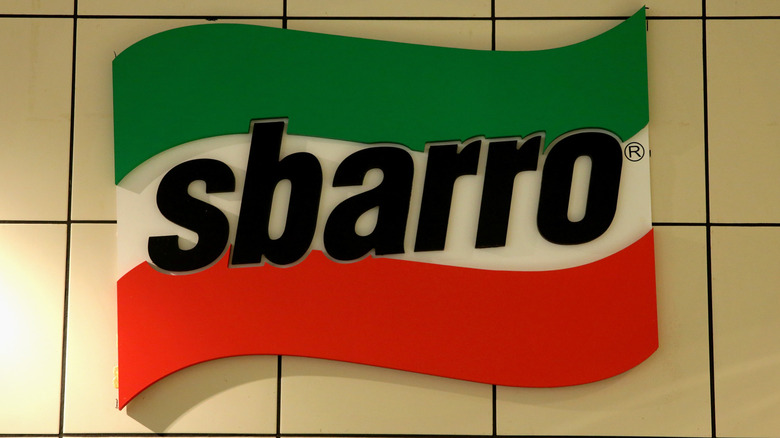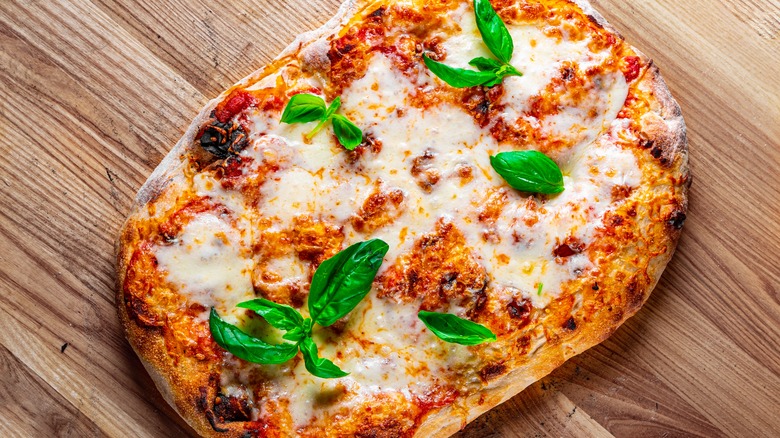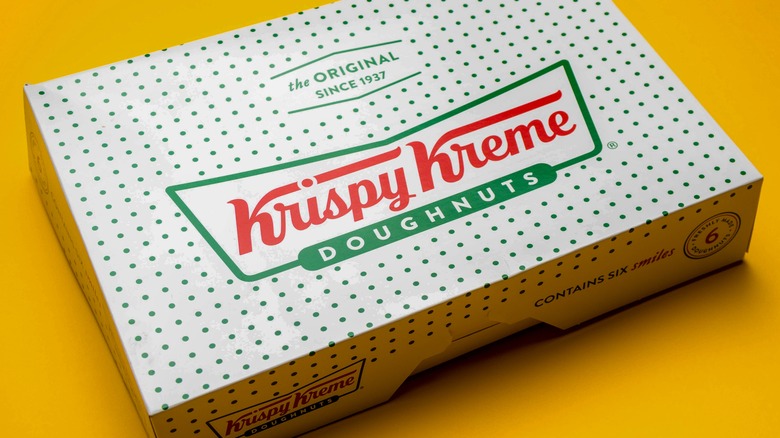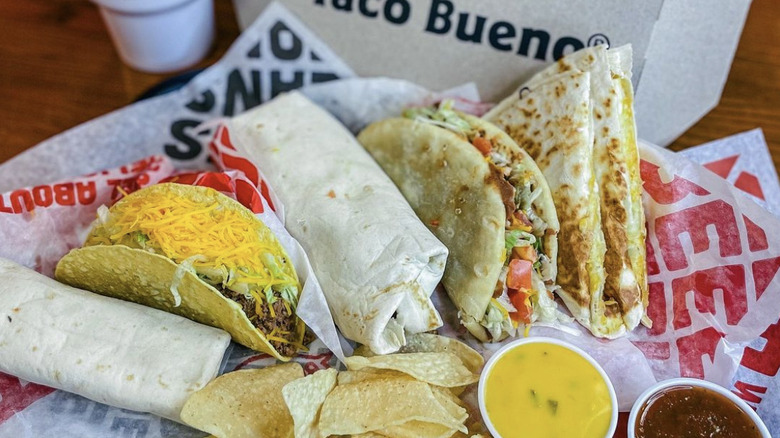12 Fast Food Restaurants That Are Disappearing
Since the mid-20th century, fast food has been a major part of American life, and it's been heavily exported to the rest of the world, too. It's no wonder that such grab-and-go fare has become an omnipresent and definitive part of food culture — fast food is not only fast, but it's also inexpensive, boasts broad appeal, and is generally loaded with the things that make the tongue, stomach, and brain happy, in the form of sugar, fat, carbs, and salt.
Dozens of national chains have become institutions over the decades, but, like any other business sector, fast food is competitive and the only constant is change. New players frequently come in, pushing old ones out. Or, the new ones can't quite make a go of it. The result: The fast food industry is constantly in flux. Here are a bunch of once-popular fast food places that are already in the process of disappearing.
1. BurgerIM
BurgerIM is a stylized take on "burgerim," which, in Hebrew, means "many burgers." Company founder Donna Tuchner was born in Israel, went to culinary school in New York, and then returned home to open a BurgerIM in Tel Aviv in 2011. Entrepreneur Oren Loni bought the rights to franchise the restaurant, and by mid-2016, 168 BurgerIMs were up and running, with 30 more scheduled to open by the end of that year. What made BurgerIM so different, and so explosively popular, was the food. The upscale place sold miniature hamburgers in packs of two, and in 10 high-quality varieties, including Wagyu beef and lamb. All burgers arrived on brioche-style buns with sesame seeds and were topped with nontraditional condiments like pineapple and avocado.
BurgerIM looked to be a victim of its own success — it expanded too quickly. By the end of 2019, over 1,200 franchising agreements were in place. That same year, BurgerIM nearly filed for bankruptcy. They didn't, but they still pulled back in a major way. The company settled a lawsuit with franchisees over allegedly shady and deceptive contracts in 2021. That cost BurgerIM a significant $57 million, and by that point, the chain had shrunk to about 125 outlets.
2. Pie Five
Pizza is almost universally beloved, but there's one place where fast food competitors like burger and chicken joints have it beat: speed. It can take 20 minutes or more to score a hot pie at traditional pizza parlor chains. And then came pizza makers like Pie Five. The chain starts with the business model of something like Chipotle — customers customize their pizza with toppings of their choice as it's assembled before their eyes. And then the pizza is flash-baked in a high-speed oven, where it's ready in five minutes.
The COVID-19 pandemic and the lengthy lockdown and shutdown orders implemented to slow the spread of the virus hurt business at dine-in restaurants in general, although delivery-oriented pizza actually enjoyed a revenue boom. Pie Five's experience, however, was quite the opposite. In 2017, the pizza chain had reached the 100-store benchmark. By January 2023, only 28 Pie Fives remained.
3. Steak 'n Shake
What Steak 'n Shake does, and does differently than its many competitors, is right there in the name. "Steak" is short for "Steakburger," the restaurant chain's line of burgers traditionally made by combining several high-quality varieties of ground steak. And the "Shake" refers to its hand-dipped, old-fashioned, extra-sweet, extra-thick, cherry-topped milkshakes. By January 2019, that formula had launched more than 620 Shake 'n Shake outlets in the United States.
But the idyllic, nostalgic calm of any given Steak 'n Shake belies some significant behind-the-scenes machinations and broad attempts at solving big problems quickly. Just four years after topping 600 locations, Steak 'n Shake had cut its store count down to 454. In 2019, 103 restaurants temporarily closed over two rounds of company orders. In May 2020, 51 locations were shuttered permanently, and another 30 or so restaurants had stopped doing business by November. The future doesn't look so sweet for Shake 'n Shake, which has faced such tough times that the company considered dropping those iconic cherries from the shakes because it could've saved $1 million annually.
4. Quiznos
The first chain to really give Subway a run for its money in the long sandwich game was Quiznos. By 2006, the operation ran a robust 5,000 stores, attracting a large level of business with its cheesy, hot, proudly oven-toasted sandwiches. That set Quiznos apart from the likes of Subway, which primarily offered cold, not-toasted sandwiches.
Things began to go cold for Quiznos with the arrival of the Great Recession of the 2000s. Quiznos further suffered when similar fast-casual restaurants attracted away its customers. The chain also spent a lot on office space, and franchisees became unhappy about shrinking profit margins. By 2021, closures, a sale of the company, and restructuring had reduced Quiznos to under 300 American outlets. In May of that year, Quiznos announced a plan to do away with a lot of retail locations in favor of ghost kitchens. By early 2023, the chain was down to a mere 163 sandwich shops in the U.S.
5. Boston Market
In the 1990s, Boston Market was a fixture across the United States, selling old-fashioned, homestyle fare like herb-heavy rotisserie-style chicken, meat loaf, mashed potatoes and gravy, and macaroni and cheese. But then Boston Market (formerly known as Boston Chicken) botched its own ambitious expansion plans. The chain raised a fortune with its stock IPO and then loaned that money to multi-store franchisees who could quickly open several stores in one area at once. Those outlets generated profits, and a hefty cut in royalties for the parent company, which in turn started the whole mega-expansion plan up again.
But when those franchised stores experienced financial problems, many had to close — by 2015, Boston Market's imprint had fallen from more than 1,100 stores to around 460. That year, the company attempted a reboot, updating its long unchanged menu with new items to compete with hipper, newer outlets, but it didn't necessarily work out. Boston Market continues to slowly fade out — as of 2023, 285 Boston Market restaurants remained open in the U.S.
6. Noodles & Company
Noodles & Company wanted to serve the whole world, it seems. So many cultures around the world count noodles as a dietary staple and comfort food, and this quick-serve chain put a lot of them on their menu. This makes Noodles & Company unparalleled among fast food in the variety of cultures it represents. The place sells and quickly turns around plates of noodles and pasta inspired by the cuisines of Italy, China, Korea, and Japan, among others, along with soups and salads.
Over the last half-decade or so, Noodles & Company has just kept slipping. In 2016, the home office recorded a net loss of $71.7 million, including the $10.6 million it spent resolving claims over a data breach. In 2017, Noodles & Company closed a number of outlets (though it also opened some) while also thinking about selling corporate-owned spots to franchises. Noodles & Company lost around $8 million in the final quarter of 2021, which it attributed to coronavirus issues. In the first quarter of 2022, it lost another $6.4 million, necessitating a 10% price increase.
Noodles & Company soldiered on, and as of early 2023, 466 outlets peppered the United States.
7. Qdoba
Qdoba began in Denver in 1995 as a food stand. Founders Anthony Miller and Robert Hauser looked to create a Mexican fast food outlet that focused on healthier ingredients and customized ordering. That concept evolved into a chain of more than 700 Qdoba locations as of 2023, where customers can direct the assembly of their own burritos, tacos, and bowls. Qdoba's concept closely matches that of Chipotle, which operates more than four times as many restaurants in the U.S.
And it would seem that Chipotle is winning this head-to-head battle of bespoke, healthy-leaning, Mexican-inspired quick-serve chains. As early as 2013, Qdoba started reducing itself, closing 67 restaurants that year. A revolving door of buyers and sellers probably doesn't bode well, either. Jack in the Box owned Qdoba from 2002 to 2017, selling it to Apollo Management Group in 2017, which unloaded it relatively quickly in 2022 to Butterfly Equity. About 20 additional Qdobas across the country had closed by early the next year.
8. Krystal
One of the South's most distinctive restaurant chains, Krystal was also one of the region's first. Founded in Tennessee in 1932, the chain with the familiar red-and-white signage offers signature mini-sized fast food favorites. Apart from the square, slider-style Krystal burgers, the chain sells small chicken sandwiches, little corn dogs, tiny hot dogs, and also plate breakfasts.
Even before pandemic-era lockdown orders in 2020 led to widespread restaurant struggle, Krystal was having issues. In January 2020, the chain filed for Chapter 11 bankruptcy protection after closing 44 restaurants in 2019 failed to get finances back on track. Krystal's filings cited competition with online delivery services and the increasing cost of labor as notable causes. At the time of its bankruptcy filing in 2020, 298 Krystal outlets were in operation. In May 2020, Krystal was able to pull out of bankruptcy after a purchase by Fortress Investment for $49 million. Three years later, and despite a promised plan to grow in the coming years, there were fewer Krystal outlets than there were pre-bankruptcy, so the future is hazy for the burger chain.
9. Sbarro
In the crowded field of pizza, Sbarro found a once-lucrative niche — selling their product by the slice (huge, thick, doughy slices) to captive consumers at places like mall food courts and airports. Sbarro began in 1956 as an Italian grocery store in Brooklyn, founded and run by a family of newly arrived immigrants from Naples. As Americans' shopping habits took them from freestanding stores and into shopping malls, Sbarro went with them.
In the 21st century, whenever a broad, sweeping economic crisis hit, Sbarro indirectly felt the brunt. In 2011, the company filed for Chapter 11 bankruptcy protection when sales cratered during the late 2000s recession, when millions refrained from both going to malls as much in addition to eating out. Sbarro recovered somewhat, but in 2014, the chain filed for bankruptcy again, citing significant debt and decreasing revenues on account of how fewer and fewer people went to shopping malls anymore. By the time of the second filing, Sbarro had already shut down 180 outlets and planned to shutter more of its North American branches.
When malls shut down and air travel decreased during the COVID-19 pandemic in 2020, Sbarro's sales dropped by another 18%. Nevertheless, in 2022, the company announced plans to move out of malls and open 100 Sbarro-branded outlets primarily inside convenience stores and gas stations.
10. Così
Così is the rare American fast food brand that began in Europe. The chain started in Paris in the '80s and expanded into the U.S. in the '90s, offering a classy, continental alternative with its flatbread sandwiches and pizzas. Così has been on rocky financial terrain almost the entire time it's been in the Americas, losing money annually from 1998 through 2015 and then filing for bankruptcy in 2016. A new private ownership took over at that point, but the company continued to slowly burn out, closing stores here and there through to early 2020, when Così went up for sale.
In February 2020, Così filed for bankruptcy for a second time, announcing plans to refocus their business on catering rather than direct-to-customer food sales. The retail outlets are harder to find than ever, which is never a good sign: After peaking with 151 stores in 2008, Così had only 22 U.S. outlets in early 2023.
11. Krispy Kreme
Doughnuts can be procured from plenty of chains and thousands of convenience and grocery stores, but Krispy Kreme has hung in there as an industry leader since opening their first shop in North Carolina in 1937. The company's yeast-raised recipe is the basis for many varieties of doughnuts available at Krispy Kreme's retro-looking locations, where customers can see them come off the production line and eat them while they're still hot.
As of 2023, 359 Krispy Kremes were open and ready to serve up hot coffee and hot doughnuts. That's a number that had shrunk a bit. In August 2017, Krispy Kreme CEO Michael J. Tattersfield announced that the company would take a look at its business model and subsequently close around 10 stores because of diminished profits. In November 2022, Krispy Kreme made plans for another round of shutdowns in the year ahead. All that, plus a stated commitment to increasing automation in its stores to reduce its debt, suggests that Krispy Kreme's problems may continue for some time.
12. Taco Bueno
Taco Bueno started out in Abilene, Texas, in 1967 and sells various varieties of tacos, burritos, and nachos, along with an original, signature creation called the Muchaco — a meat and refried bean taco served in pita bread. The restaurant grew into a regionally dominant chain in Texas, Oklahoma, and Arkansas.
In 2018, however, the Taco Bueno corporate offices took action to address financial issues, hiring former Krystal executive Omar Janjua, who immediately sought out the chain's worst-performing restaurants. The goal: Close them down and stop spending money on those money pits. In September 2018, Taco Bueno shut down 16 locations. Earlier in the year, Taco Bueno had pulled out of Colorado Springs entirely. All those closures presaged a bankruptcy, for which the chain filed in November 2018. Another 12 restaurant shutdowns soon followed. Sun Holdings bought the company in 2019, taking Taco Bueno out of bankruptcy.
In 2021, Taco Bueno planned a self-reboot, with a new store prototype to be used as the chain attempted to rebuild itself. But still, as of December 2022, Taco Bueno was down to just 139 locations, mostly in Texas and Oklahoma.
